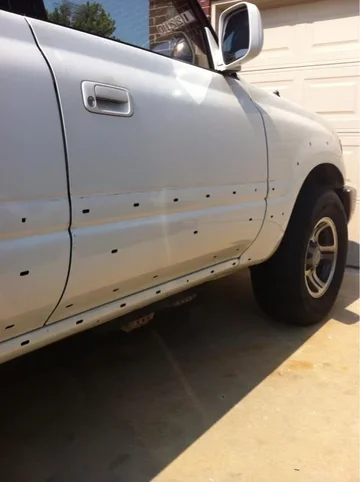Having more experience with this than most...

I'd originally planned liner, but having spent a year on rust abatement for an older LC, I'm changing plans back to paint and my welding job sucks for paint.
If liner is determined to be the definitive plan, this method would work fine.
Unless willing to pull panels to afford access to the back side of the hole, to back with an aluminum block, the holes are too large to fill with wire, without getting the panel too hot, even with a 110 mig, in my experience.
I didn't want to pull them ( in retrospect, I wish I had have and welded patches ) so wound up getting body nails, which are a composition that works well for filling holes and literally look like a sixteen penny nail.
Prepped by running a rebar wire tier in the hole to remove paint on the inside edge of the hole.
Inserted nail head in hole, tacked, moved to next.
Came back and tacked again, moved to next.
Repeat, as necessary.
Cut off the nails, grind the slag, primer, then liner.
It's a lot of hole to fill and not enough metal in the panel skin to puddle into a good patch.
In retrospect and with the experiences gained on a rusty Pig that should've been crushed, I would've pulled the panels and made 20GA patches for the holes.
Trace the hole ( or slots, in my case ) on paper, then transfer to flat stock.
Cut out of the flat stock to the inside of the traces line.
Run the wire out of the tip, then tack a 6-8" long piece to each of the patches, creating a handle.
Insert patches in hole, tack, tack, tack, tack then grind.
Little filler and she's ready for paint prep.
OR
Buy non-US body panels and call it a day, especially before welding the 162 holes that riddle the LX body shell.

